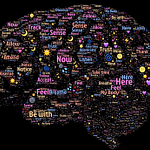Have you seen those sci-fi movies and TV serials where highly advanced robots are designed to tweak, re-engineer and maintain themselves constantly? Our brains do that every day and we take all of that for granted. (See previous post on brain plasticity).
Knowledge of brain plasticity has profound implications in human learning and behavior, and mental health.
1. No time-out: Our brains develop throughout our life. This means, that my brain is equipped for continuous learning throughout my life.
For an increasingly aged population this is excellent news. Agreed that neural networks take a longer time to establish in older people as compared to young children. However, this can be solved through perseverance and repetition.
For parents of young children, forget the undue pressure of ensuring comprehensive brain development of your child by a given age. Learning is lifelong.
2. Repetition is vital to establishing and retaining neural networks. Let’s say this one more time – repeat, repeat, repeat. This is the key to permanent learning.
Studies show that repetitive training of musicians and athletes change their brains in a permanent manner. Particular areas of the brain responsible for ‘fine’ or ’specific’ movements in certain parts of the body (e.g. the hands of a pianist or string musician) are in fact rewired for optimization.
3. Thinking is as important as doing. Physical contact is not a requirement when it comes to rewiring. Repeated thinking (and feeling) can also trigger a series of reactions which result in brain rewiring. We know that training for athletes and sports people is not limited to physical training. It also involves them visualising their moves and results. Why is this significant? This is because both doing and thinking can bring changes to the brain’s structure.
Scientists have investigated the formation of synapses as a result of ‘thinking about doing something’ and found that, from a neuronal perspective, thinking can be as useful as doing.
4. Let’s not forget feeling. Modern science is exploring the impact of emotions on the brain. The science of co-relating feelings and the brain functions is called affective neuroscience.
Studies like those by Joseph LeDoux at the Center for Neuroscience at NYU show that the part of the brain responsible for strong emotions such as fear and rage, will be triggered before the “rational, thinking” part of the brain is triggered. This implies that emotions play a big part in the ability to think and learn effectively.
Extrapolating the concept of brain plasticity to emotions, one could say that any emotion that is repeated changes the brain structure. New emotions take time especially if the brain is not used to it. People who are habitually angry take time and need to put in a lot of effort to create new neural pathways that do not involve anger. However, after a few attempts at navigating this neural pathway, subsequent journeys become a walk in the park.

5. Rewiring Possibilities: This means that the brain learns to adapt and change itself depending on its environment and the stimulus it receives. There are many documented examples of accidents, brain traumas and other critical instances where the human brain has rewired itself to re-establish functional connections that were considered to have been lost or seriously affected.
Terry Wallis from Massachusetts (US), was a patient who spent 19 years in a coma. When scientists scanned his brain combining PET (Positron Emission Tomography) and DTI (Diffusion Tensor Imaging) technologies, they found evidence that Wallis’s brain had “developed new pathways and completely novel anatomical structures to re-establish functional connections, compensating for the brain pathways lost in the accident” (New Scientist, 03/07/2006).
6. Recovery from Stroke : During a stroke, a part of the brain is deprived of blood and oxygen for an prolonged period of time. Deprived of oxygen, the affected part of the brain dies fairly quickly. As a result, the brain is unable to perform the related tasks of the affected part of the brain. However, by working with physical, occupational and speech therapists, recovering stroke patients can regain some or all of the abilities that they once lost.
Brain plasticity is responsible for this process of recovery. The brain cells that die from the stroke will never return. So the therapists work to recruit and train other, healthy brain cells. Through repeated effort, the brain cells actually go through small structural changes so that they can begin performing the functions that were lost in the stroke.
7. Addiction – The bad news and the good
Unfortunately, brain plasticity is not always so rosy. It plays a big role in the addictive properties of certain drugs. One use of cocaine causes a fairly vigorous degree of brain plasticity such that the reward circuits are changed. From then on, the brain actively seeks out more of the drug in order to duplicate that same pleasurable sensation. Repeated use of the drug can further reinforce the brain plasticity and addiction.
The good news is that recovery from addictive drugs also involves brain plasticity. And you guessed it! It takes longer to recover from addiction and even longer to recover on a permanent basis. So in this case, abstinence is definitely easier than cure.
8. Reinventing Ourself
Life has a way of throwing us in the deep end. We go through situations that put us in dark places and have to then go through the challenging job of rebuilding our life. Rebuilding can be learning to live in a new environment, learning new skills, a new way of thinking, a new way of being and believing in our self and our abilities to rise to the challenge. Brain Plasticity gives us the hope that this is possible for all of us.

